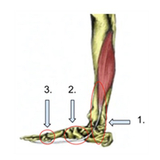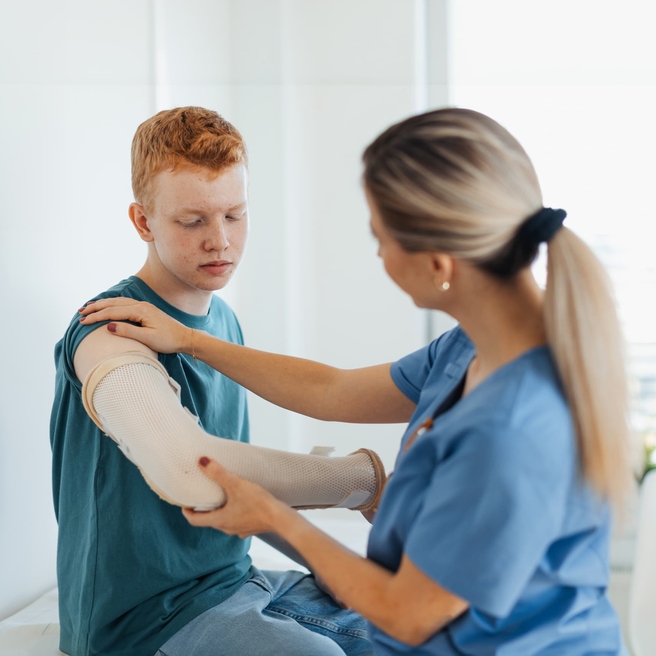What is flexor hallucis longus (FHL) tendonitis?
The flexor hallucis longus tendon is a strong, fibrous cord that connects a muscle in the calf to the great toe. It passes along the inside of the ankle. The tendon, commonly called the FHL tendon, helps people flex their big toes and stand on the tips of the toes – as a ballet dancer does en pointe. When this tendon is overused, it can result in inflammation. This condition is called FHL tendonitis.

While FHL tendonitis can affect anyone, it is relatively uncommon in the general population. It is much more common in athletes – particularly dancers – who perform repetitive and forceful movements or prolonged plantar flexion (toe pointing) maneuvers.
FHL tendonitis can cause pain at the back of the ankle, under the mid-foot or the base of the big toe (see illustration). It can affect an athlete’s range of motion and cause a locking sensation in the big toe. This can severely limit the range of motions an athlete can perform.
Causes of FHL tendonitis
While FHL tendonitis may be caused traumatically due to high force going through the tendon, it is more commonly caused by gradual wear and tear linked to overuse of the tendon and nearby muscle groups.
Repeatedly pushing off from the big toe can irritate the tendon and cause it to be inflamed. This type of injury is most common in performance athletes – particularly ballet dancers who spend significant time rising on their toes.
Other factors that may contribute to FHL tendonitis include:
- Inadequate warm up or muscle weakness
- Incorrect technique
- Inadequate rehabilitation after an earlier injury
- Poor foot mechanics, such as flat feet
- Limited flexibility
- Inappropriate footwear for the specific activity being performed
Symptoms of FHL tendonitis
In most cases, FHL tendonitis causes pain, particularly on the inside of the ankle, which may travel down to the big toe. In most cases, pain develops gradually over time and after repetitive muscle contractions – e.g., standing on the balls of the feet, running, jumping, etc. – rather than from a single traumatic event (though this is also possible).
Other common symptoms include:
- Pain that worsens when the athlete pushes off from their toes
- Swelling in the ankle
- A clicking sensation or sound in the ankle, particularly when flexing the great toe
- Stiffness after resting the affected leg
- Pain when touching the FHL tendon along its course
Diagnosing FHL tendonitis
FHL tendonitis in children and teens is typically diagnosed by an orthopedic physician, sports medicine specialist or pediatrician.
At Children’s Hospital of Philadelphia (CHOP), a physician will perform a physical examination, ask about symptoms, and learn your child’s medical history. Imaging tests such as an MRI scan, CT scan or ultrasound may be ordered to provide more detailed images of the muscles, tendons and tissues in the affected leg and ankle. Results from imaging tests help guide treatment decisions.
Treatment of FHL tendonitis
In most cases, treatment for FHL tendonitis is conservative and non-surgical. It may include:
- Rest to decrease swelling and avoid activities that cause pain. Patients may use crutches, a cast or a special boot to limit foot and ankle movements.
- Ice and anti-inflammatory medications, such as ibuprofen or naproxen, to dull pain and reduce inflammation. Topical anti-inflammatories, such as diclofenac gel, can also be helpful.
- Compression and elevation to stabilize the ankle joint and reduce swelling.
- Early physical therapy to promote healing, strengthen the tendon, increase range of motion and retrain the biomechanics of the foot and ankle. This may include:
- Soft tissue massage
- Electrotherapy to reduce pain, improve circulation, and repair/strengthen muscles
- Stretches or prescribed exercises to do at home, such as dance technique retraining to reduce “winging” or “rolling in” while using modified turnout positions and eliminating certain movements known to cause pain such as en pointe, grand plie and jumps.
- Footwear advice, including the use of arch supports for everyday wear and when not in competition.
- Ultrasound-guided injections of corticosteroids (anti-inflammatory medication) into the ankle may provide pain relief, increase the patient’s range of motion and promote healing
In rare cases – if rest and conservative treatments fail to improve symptoms and the severity of tendon damage is extensive – surgery may be recommended to treat FHL tendonitis. Recovery after surgery is typically about three months, then physical activity can slowly be reintroduced as tolerated.
Follow up care for FHL tendonitis
In most cases, your child will be able to resume their typical activities within a few weeks after rest and conservative treatments described above.
In some cases, youth will be encouraged to continue stretching exercises beyond the initial rehabilitation period. These exercises can be performed at home and are generally recommended to be completed three times a day:
- Foot and ankle up and down. While your child is lying down with a straight leg, instruct them to move their foot and ankle up (pointed toward the sky) and then down (pointing toward the wall) as far as possible without pain. Repeat 10-20 times if no increase in symptoms.
- Foot and ankle in and out. While your child is lying down with a straight leg and foot pointed toward the sky, instruct them to move their foot and ankle from side to side (rotating the ankle in and out) as far as possible without pain. Repeat 10-20 times if no increase in symptoms.
- Lunge stretch. While your child is facing a wall, instruct them to place their hands on the wall at about shoulder height, then place one foot in front of the other, with heels on the ground. Gently move the knee forward over the toes (lunging) as far as comfortable without pain. Hold the stretch for 5 seconds and repeat 10 times per leg if no increase in symptoms.
Encourage your young athlete to take breaks as needed and not push themself too hard to avoid possible reinjury – which may ultimately prolong their recovery from FHL tendonitis.

Why choose CHOP
We have more specially trained sports medicine physicians, orthopedic surgeons, physical therapists and athletic trainers than any other pediatric orthopedic facility in the region.
Resources to help
Sports Medicine and Performance Center Resources
We have created resources—including patient and family educational materials, videos, and more—to help you find answers to your questions and feel confident about the care you are providing your child.
